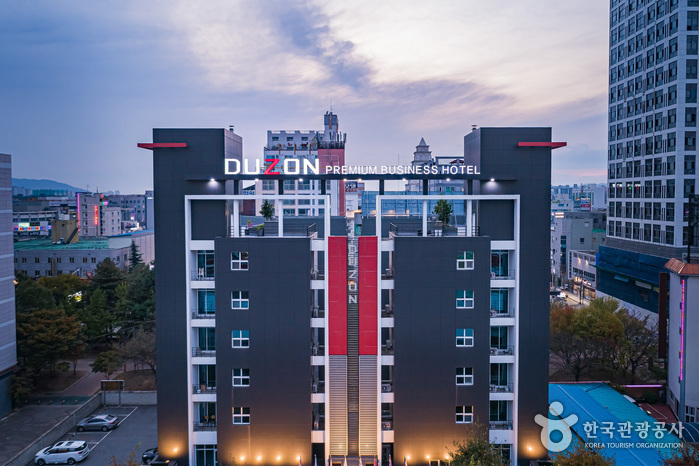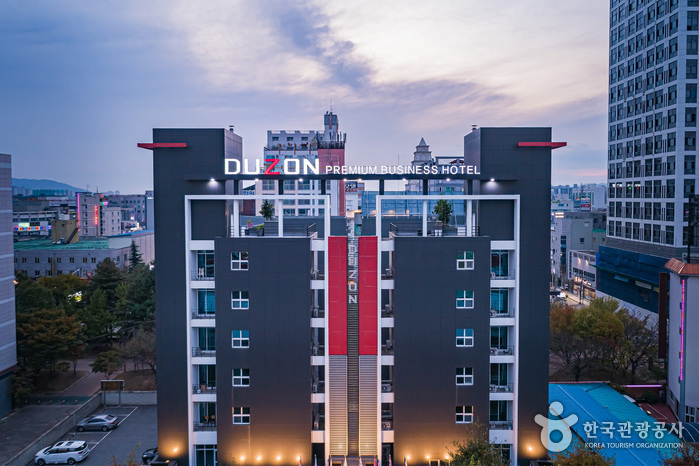Olive Young - Gwangju Suwan Branch [Tax Refund Shop] (올리브영 광주수완)
10.6Km 2024-04-22
342, Imbangul-daero, Gwangsan-gu, Gwangju
-
Noble Stay Hotel (노블 스테이 (Noble Stay))
10.6Km 2024-12-22
19-7 , Imbangul-daero 826beon-gil, Gwangsan-gu, Gwangju
+82-62-445-7700
Noble Stay is a cutting-edge business hotel in Gwangsan-gu, Gwangju, Jeollanam-do. It has 94 rooms, all finished in white and wood, and equipped with air purifiers and clothing stylers. In the top floor Sky Lounge you can take breakfast while enjoying fine views over the city. If provisions are needed, there’s a food alley and a supermarket nearby.
Duzon Hotel A (더존호텔A)
10.7Km 2024-12-22
60-37 , Imbangul-daero 826beon-gil, Gwangsan-gu, Gwangju
+82-62-973-6699
Duzon Hotel A in Gwangsan-gu, Gwangju, Jeollanam-do, is located in Gwangju’s high-tech district where the Gwangju Institute of Science and Technology and Government Complex 2 are based. The hotel is just 20 minutes from Gwangju Airport and KTX Songjeong-ri Station, while tourist destinations such as Damyang and Jangseong are also nearby. It is good for an accommodation for academic societies, Namdo tours, and golf trips.
Duzon Hotel (더존호텔)
10.7Km 2024-12-22
60-37 , Imbangul-daero 826beon-gil, Gwangsan-gu, Gwangju
+82-62-973-6699
Duzon Hotel in Gwangsan-gu, Gwangju, Jeollanam-do, is located in Gwangju’s high-tech district where the Gwangju Institute of Science and Technology and Government Complex 2 are based. The hotel is just 20 minutes from Gwangju Airport and KTX Songjeong-ri Station, while tourist destinations such as Damyang and Jangseong are also nearby. It is good for an accommodation for academic societies, Namdo tours, and golf trips.
Hotel the Spot [Korea Quality] / 호텔더스팟[한국관광 품질인증/Korea Quality]
10.7Km 2020-12-10
32, Amkor-ro, Buk-gu, Gwangju
+82-10-2417-6500
Located in Gwangju’s Buk-gu district, HOTEL THE Spot is an ideal base camp for traveling around the province. The hotel faces a park and the Yeongsangang River, suitable for leisurely walks. HOTEL THE Spot offers a “comfortable space like home,” with a special emphasis on room comfort and attentive services. Each room is furnished with a comfortable bed, work desk, minibar, wardrobe, and a PC with high-speed Internet for the traveler's comfort. Its interior design features white, gray, and wood tones for a trendy and comfortable touch. The hotel also serves free homemade breakfast every morning. There are 38 rooms in total, which are divided into the city and park views. The Studio Suite is equipped with a sink, cooking utensils, and a wide table, which are ideal for large families or groups looking for small event venues. For family travelers with young children, the hotel recommends the Superior Super King room, furnished with a super-king-sized bed. Other rooms include the Superior Double (city view), Deluxe Double, Deluxe Twin, and Suite Double. The Suite Studio has a bathtub rather than a shower for relaxation. Moreover, other amenities include the cafeteria, laundromat (payment required), and complimentary styles. The hotel also provides valet parking and concierge services.
Olive Young - Gwangju Hanam Columbus Branch [Tax Refund Shop] (올리브영 광주하남콜럼버스)
10.8Km 2024-04-18
Store #103, #104, 38-6, Saam-ro 216beon-gil, Gwangsan-gu, Gwangju
-
E-Mart - Gwangsan Branch [Tax Refund Shop] (이마트 광산)
10.9Km 2024-04-22
172, Saam-ro, Gwangsan-gu, Gwangju
-
Lotte Mart - ToysRus Suwan Branch [Tax Refund Shop] (롯데마트 토이저러스수완점)
10.9Km 2024-04-16
3F & 4F, 98, Jangsin-ro, Gwangsan-gu, Gwangju
-
MLB - Lotte Suwan Branch [Tax Refund Shop] (MLB 롯데수완)
10.9Km 2024-04-17
1F, 98, Jangsin-ro, Gwangsan-gu, Gwangju
-
Tandy - Lotte Suwan Branch [Tax Refund Shop] (탠디 롯데수완)
10.9Km 2024-04-23
124, Singomae-ro, Giheung-gu, Yongin-si, Gyeonggi-do
-
![Olive Young - Gwangju Suwan Branch [Tax Refund Shop] (올리브영 광주수완)](http://tong.visitkorea.or.kr/cms/resource/64/2886964_image2_1.jpg)



![Hotel the Spot [Korea Quality] / 호텔더스팟[한국관광 품질인증/Korea Quality]](http://tong.visitkorea.or.kr/cms/resource/77/2651577_image2_1.jpg)
![Olive Young - Gwangju Hanam Columbus Branch [Tax Refund Shop] (올리브영 광주하남콜럼버스)](http://tong.visitkorea.or.kr/cms/resource/79/2886979_image2_1.jpg)
![E-Mart - Gwangsan Branch [Tax Refund Shop] (이마트 광산)](http://tong.visitkorea.or.kr/cms/resource/86/2886986_image2_1.jpg)
![Lotte Mart - ToysRus Suwan Branch [Tax Refund Shop] (롯데마트 토이저러스수완점)](http://tong.visitkorea.or.kr/cms/resource/41/2886941_image2_1.jpg)
![MLB - Lotte Suwan Branch [Tax Refund Shop] (MLB 롯데수완)](http://tong.visitkorea.or.kr/cms/resource/44/2886944_image2_1.jpg)
![Tandy - Lotte Suwan Branch [Tax Refund Shop] (탠디 롯데수완)](http://tong.visitkorea.or.kr/cms/resource/48/2886948_image2_1.jpg)
 English
English
 한국어
한국어 日本語
日本語 中文(简体)
中文(简体) Deutsch
Deutsch Français
Français Español
Español Русский
Русский